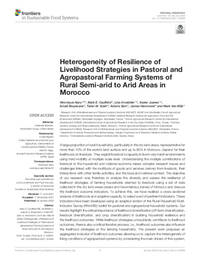Heterogeneity of Resilience of Livelihood Strategies in Pastoral and Agropastoral Farming Systems of Rural Semi-arid to Arid Areas in Morocco

Authors:
A large proportion of rural households, particularly in the dry land areas, representative for more than 10% of the world's land surface and up to 80% in Morocco, depend for their livelihoods on livestock. They exploit livestock's capacity to live in very harsh environments using herd-mobility at multiple scale level. Understanding the multiple contributions of livestock to the household and national economy raises complex research issues and challenges linked with the multitude of goods and services derived from livestock, their interactions with other family activities, and the local and national context. The objective of our research was therefore to analyse the diversity and assess the resilience of livelihood strategies of farming households oriented to livestock using a set of data collected in the dry land areas (oases and mountainous zones) of Morocco and discuss the livelihood outcome indicators. To achieve this, we have realized a cross-sectional analysis of livelihoods and adaptive capacity, to select a set of pertinent indicators. These indicators have been developed using an adapted version of the Rural Household Multi-Indicator Survey (RHoMIS) toolkit for pastoral and agropastoral household systems. Our results highlight the critical importance of livelihood diversification (off-farm diversification, livestock diversification, and crop diversification) in building household resilience and the livelihood outcomes. While livelihood strategies undoubtedly contribute to livelihood outcomes, there is also a critical iterative process, i.e., livelihood outcomes also influence the livelihood strategies at the farming households. The present work proposes an aggregated indicator of livelihood outcomes allowing us to capture the heterogeneity of living conditions of agropastoral systems by considering the main drivers of this system, i.e., mobility, livestock species, and physiological stage composition of the herd. This approach could constitute a valuable contribution to help fill the knowledge gaps that do not allow policy makers in developing contextualized rural development policies and instruments in these very harsh environments.
